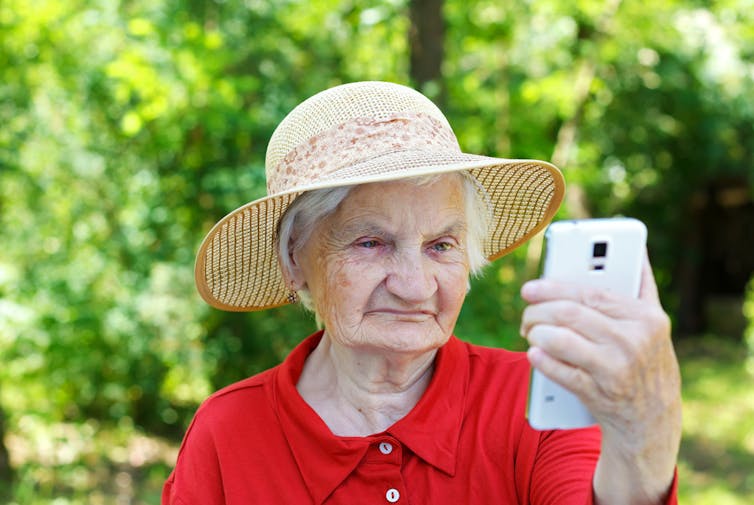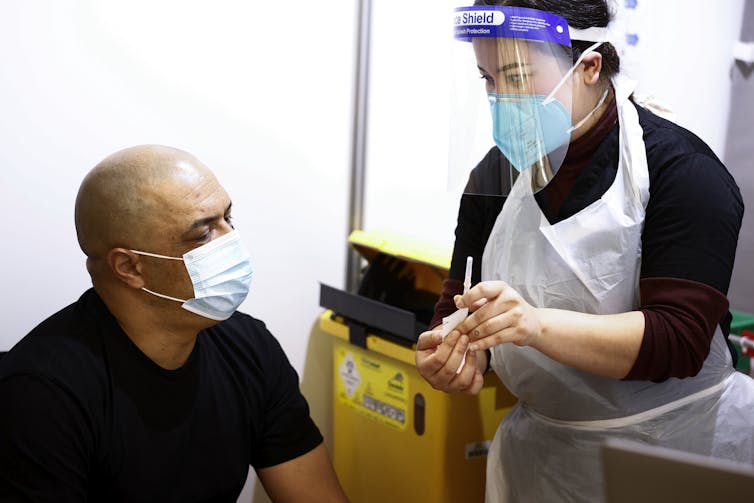
Danielle Marie Muscat, University of Sydney; Julie Ayre, University of Sydney; Kirsten McCaffery, University of Sydney, and Olivia Mac, University of SydneyAs Sydney’s COVID-19 outbreak continues to grow, the message has shifted to urgently “get the jab”. And people’s motivation to get vaccinated is increasing.
But with ever-changing advice, many people are confused about which vaccine they’re eligible for and where to get an appointment.
Our recent review, which has been accepted for publication in the Medical Journal of Australia, shows information for the public about COVID vaccines is too complex to read, understand and act upon. It’s even more complex than other COVID public health advice, such as for physical distancing or masks.
Then there’s the results of our recent survey, which has yet to be peer reviewed, of where people from culturally and linguistically diverse (CALD) communities get their COVID information from. This finds a huge diversity of sources, beyond official government websites. So we need to tailor communications to these communities via channels people actually use.
Taken together, our research shows we are still missing clear and consistent communication about COVID vaccines all Australians can understand and act on.
No wonder people are confused
We looked at publically available COVID-19 information from government websites from Australia (federal and three states), the United Kingdom, New Zealand, and three international public health agencies (including the World Health Organization).
Most public information was above the recommended reading level for the general population (8th grade).
In Australia, information was commonly written at postgraduate level. This means it is too difficult for people with average reading ability to understand. It’s likely even harder for the 9 million Australians who have lower health literacy.
Vaccination information from the federal government website was the only Australian material to adequately outline the action or steps readers needed to take to get vaccinated. Websites from all three states (New South Wales, Queensland, Victoria) we reviewed did not.
This means there has been little progress nationally or internationally in terms of improving the readability of written COVID-19 information since April 2020.
Culturally and linguistically diverse Australians
Our review does not begin to capture the additional limitations of COVID-19 communications for CALD communities.
People from CALD backgrounds form a significant and growing share of Australia’s population. For instance, 43% of the population of southwest Sydney (one of the focuses of the current COVID-19 outbreak) was born overseas; up to 71% in certain local government areas speak a language other than English at home.
Yet, translated information and communications about COVID-19 have been sparse, intermittent and not all has been appropriate. The original source materials in English are too complex, official translators are not used, and/or translations are not reviewed to make sure the information makes sense.
There has been some progress
We’ve had some progress this week. Press briefings, crucially important for keeping up-to-date about new rules and regulations, have only in the past few days been made available in any other language than English.
Similarly, the online vaccination eligibility checker has only just been translated into 15 other languages. However, the online vaccine clinic finder, which you reach at end of the vaccine eligibility checker, remains only in English.
More positively, a COVID-19 vaccination glossary (with clear descriptions of complex vaccine terms) is now available in 29 languages.
But more work is needed
However, more work is needed to ensure COVID information is “distributed widely” to CALD communities via the most appropriate channels, as recommended in the Australian government’s own plan.
Our recent survey of over 700 CALD community members in Greater Western Sydney showed just over half (about 54%) of participants used official government sources to find out about COVID-19. However, this varied greatly between language groups, reaching as low as 29% for some.
Social media (52%), family and friends (33%), and community sources (26%) were also common pathways for seeking out information about COVID. Many sought in-language communication from overseas. For some of these groups, official sources appear less accessible or useful.
So work is clearly needed to distribute tailored communications via channels people actually use.
What actually works?
We know how to communicate public health messages clearly for diverse communities. We can:
- use everyday words for all public health communication
- test readability levels of written documents
- check the “actionability” of instructions (whether there are clear instructions of what to do next)
- use pictures, icons or animations.
We know it is possible to successfully implement these strategies. Our review identified 12 “easy-to-read” materials written at a lower reading grade that were easier to understand.
However, these were rare, difficult to find on official websites and often poorly signposted. For instance, some were on pages labelled for “people with disability”.
We need concerted action to ensure materials such as these become the “rule” rather than the exception. Plain language and in-language information simply cannot be an afterthought or “optional extra” if we are to achieve the 80% or higher vaccination rates needed to end lockdowns and return to some semblance of normal.
Read more:
Australia shouldn’t ‘open up’ before we vaccinate at least 80% of the population. Here’s why
![]()
Danielle Marie Muscat, Post-Doctoral Research Fellow, University of Sydney; Julie Ayre, Post Doctoral Research Fellow, University of Sydney; Kirsten McCaffery, NHMRC Principal Research Fellow, University of Sydney, and Olivia Mac, Research fellow, University of Sydney
This article is republished from The Conversation under a Creative Commons license. Read the original article.




You must be logged in to post a comment.